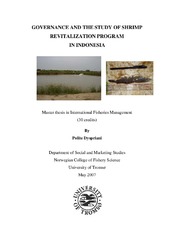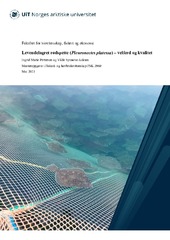Effect of three different codend designs on the size selectivity of juvenile cod in the Barents Sea shrimp trawl fishery
Permanent link
https://hdl.handle.net/10037/16226Date
2019-07-31Type
Journal articleTidsskriftartikkel
Peer reviewed
Abstract
Shrimp trawlers often use a Nordmøre sorting grid ahead of a small mesh codend to avoid bycatch of juvenile fish while allowing shrimps to be efficiently caught. However, small fish can pass through the grid to enter the codend and risk being retained. The risk of retention for fish of different sizes depends the size selection in the Nordmøre grid and the size selection in the subsequent codend, which makes the process complex and often results in a bell-shaped size selection curve. In the Barents Sea shrimp fishery, cod (Gadus morhua) is one of the species of concern because of its great commercial value. We studied the size selection of juvenile cod when the trawl was equipped with the compulsory gear in the fishery: a 19 mm Nordmøre grid followed by a 35 mm diamond mesh codend. As expected, the size selection curve showed a bell-shaped signature, with a certain size range of juveniles having high retention risk, while the risk for smaller and bigger cod was smaller. The retention risk was highest for cod between 12 and 20 cm in length. We also tested two alternative designs in the aft section of the gear: a codend with 35 mm square mesh panels and a square mesh sorting cone section. Neither of these designs affected the size selection in the trawl significantly.
Description
Publisher
ElsevierCitation
Herrmann, B., Sistiaga, M., Larsen, R.B. & Brinkhof, J. (2019). Effect of three different codend designs on the size selectivity of juvenile cod in the Barents Sea shrimp trawl fishery. Fisheries Research, 219, 105337. https://doi.org/10.1016/j.fishres.2019.105337Metadata
Show full item recordCollections
Related items
Showing items related by title, author, creator and subject.
-
Governance and the study of shrimp revitalization program in Indonesia
Dyspriani, Polite (Master thesis; Mastergradsoppgave, 2007-05-29)Shrimp world production in the last few years has shown very high growth rates. It is marked by an increasing of production volume, and by shifting from capture to aquaculture fisheries within the production system. This has occurred mostly regarding to the brackish water pond. For some years, the government has had to face hard choices in order to ensure shrimp aquaculture developed sustainable. ... -
Levendelagret rødspette (Pleuronectes platessa) – velferd og kvalitet
Pettersen, Ingrid Marie; Aaknes, Vilde Synnøve (Master thesis; Mastergradsoppgave, 2023-05-15)I dag er verdikjeden for fisk og skalldyr bygget opp rundt utnyttelse av et fåtall arter som kan fanges i store volum og med høy markedsverdi. Bruk av lite eller ikke utnyttede marine ressurser kan være en bærekraftig tilnærming for å innfri fremtidige krav og etterspørsel til fiskekonsum. Rødspette (Pleuronectes platessa) er den viktigste flatfisken i volum og verdi i europeiske fiskerier. Både ... -
Boundary construction in mandated science : the case of ICES' advice on fisheries management
Nolde Nielsen, Kåre (Doctoral thesis; Doktorgradsavhandling, 2008-11-21)What is the relationship between science and politics? What should it be? How are their respective roles conceived and acted out in practice? Should science and politics be clearly separated? How? Are there cases in which they can be usefully mixed? What cases are those, and are there some ways of mixing that are better than others? This project explores such questions by examining relationships ...


 English
English norsk
norsk


